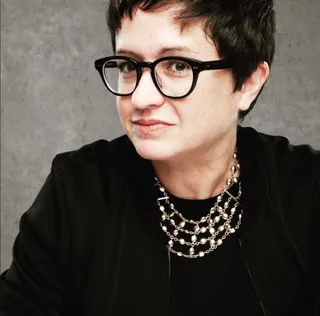BUCK! The System
"I was given space to create, explore and be myself, which at that point meant being able to cut up and talk shit in class." -- Rodney Herring

An interview with artist BUCK!, plus some recent additions to my vinyl collection, another history geek fighting the good fight, and my dog's musical tastes.
Readers,
Social media is what it is. And yet there are certain accounts out there that are just truly enchanting, delightful, and thought-provoking. We need those things, especially now. For me, one of those accounts belongs to Washington, D.C.-based artist BUCK!, who invites his Instagram followers into his studio and creative process at @buck_paints . If I see that he's doing an Instagram live, I will stop what I'm doing to see what he's up to in the studio because he's always saying and doing something interesting with his work.
Full disclosure: BUCK! and I went to middle and then high school together in Baltimore, before he enrolled at Hampton University where he majored in art and immersed himself in all the great writers, and I went to Louisiana State University to major in crawfish eating, journalism, and history. I am delighted to have reconnected with him, and hope you'll enjoy this conversation we had recently about creating in a moment like this, about committing to the process, and about engaging in a dialogue with your audience.
Go check out his Instagram account at @buck_paints, and maybe even stop by his website and see what cool stuff there is to see. So without much further ado, here comes our chat.
Enjoy!
Paige
Q&A with BUCK!
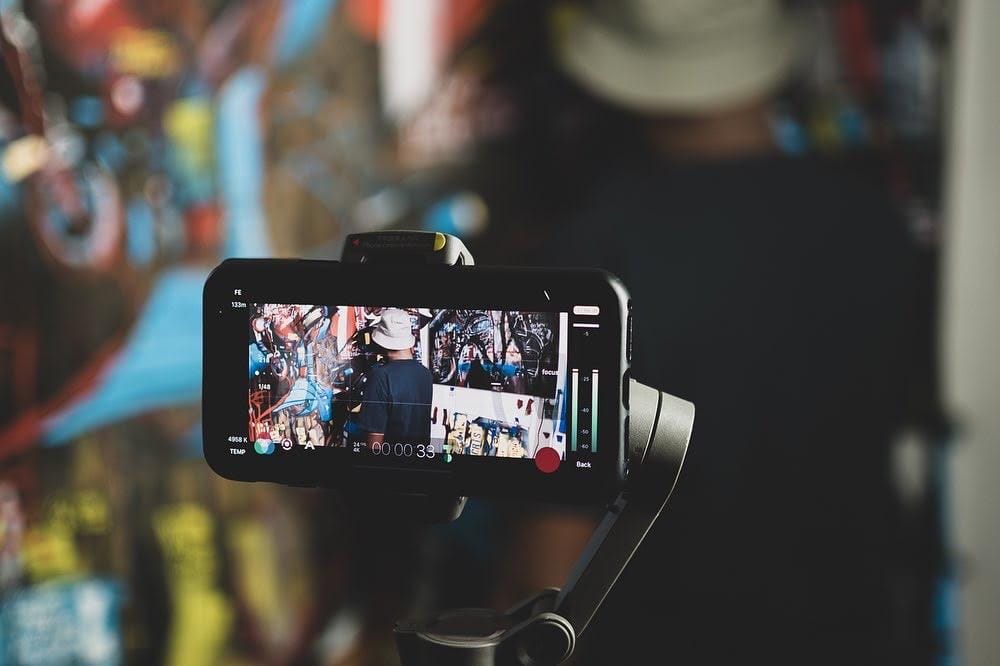
Q: What are your earliest memories of painting and creating? What were some of your favorite subjects to include in your work?
A: My earliest memories of creating were these super expansive imaginative concepts that I could never fully follow thru on…lol…I spent a lot of time with my mom while she worked her second job/career as a real estate agent. Her first job was being a business teacher at Northern High School in Baltimore City. Between those two jobs it granted me access to reams of white typing/copy paper. All I needed and required was white paper, pens and pencils and I could disappear for hours. My father used to watch World War II movies, so I used to draw a lot of in-depth war scenarios with airplanes and ships and machinery. Apparently it was detailed. But then when I was eight or nine, a buddy of mine used to draw Marvel Comics, and because I was really competitive, I'd take images from the newspaper and add to it just to be as creative as he was.
Q: Who was the first person to recognize your talent and nurture it? Tell us about them, and what that early mentoring meant to you.
A: My art teachers during my last two years of high school gave me a safe place. Between the two ladies I was given space to create, explore and be myself, which at that point meant being able to cut up and talk shit in class. One was an older white lady who smoked cigarettes, and told me as long as I sat there and drew she didn't care what I did. The next year, the teacher would look at what I did and tell me I should put it on shirts. She really encouraged me.
Q: When did you realize you wanted to become a working artist? And what was your path toward making that dream a reality?
A: The first time I ever considered being an artist I had to have been between 10-12. My mom had dropped me off at her friend’s house to sit while she worked. I was introduced to this cool-ass middle-aged, brunette-haired, overall-wearing white woman who was spending her day painting. I remember that my senses were overwhelmed in the best way possible. It was a cloudy, rainy day. I remember her row house/studio was right by the old Memorial Stadium. I remember asking her if this is what she did all day and her saying “basically yes” (I’m paraphrasing here). She was cool. My mom was a teacher and a business woman. My dad worked at Bethlehem Steel. So I had never seen anything like this, but it showed me what was possible.
Q: Which artists have influenced your work and why?
A: Emory Douglas was the graphic designer/artist for the Black Panthers. He basically created the majority of design/editorial and print work for the Black Panther Party.
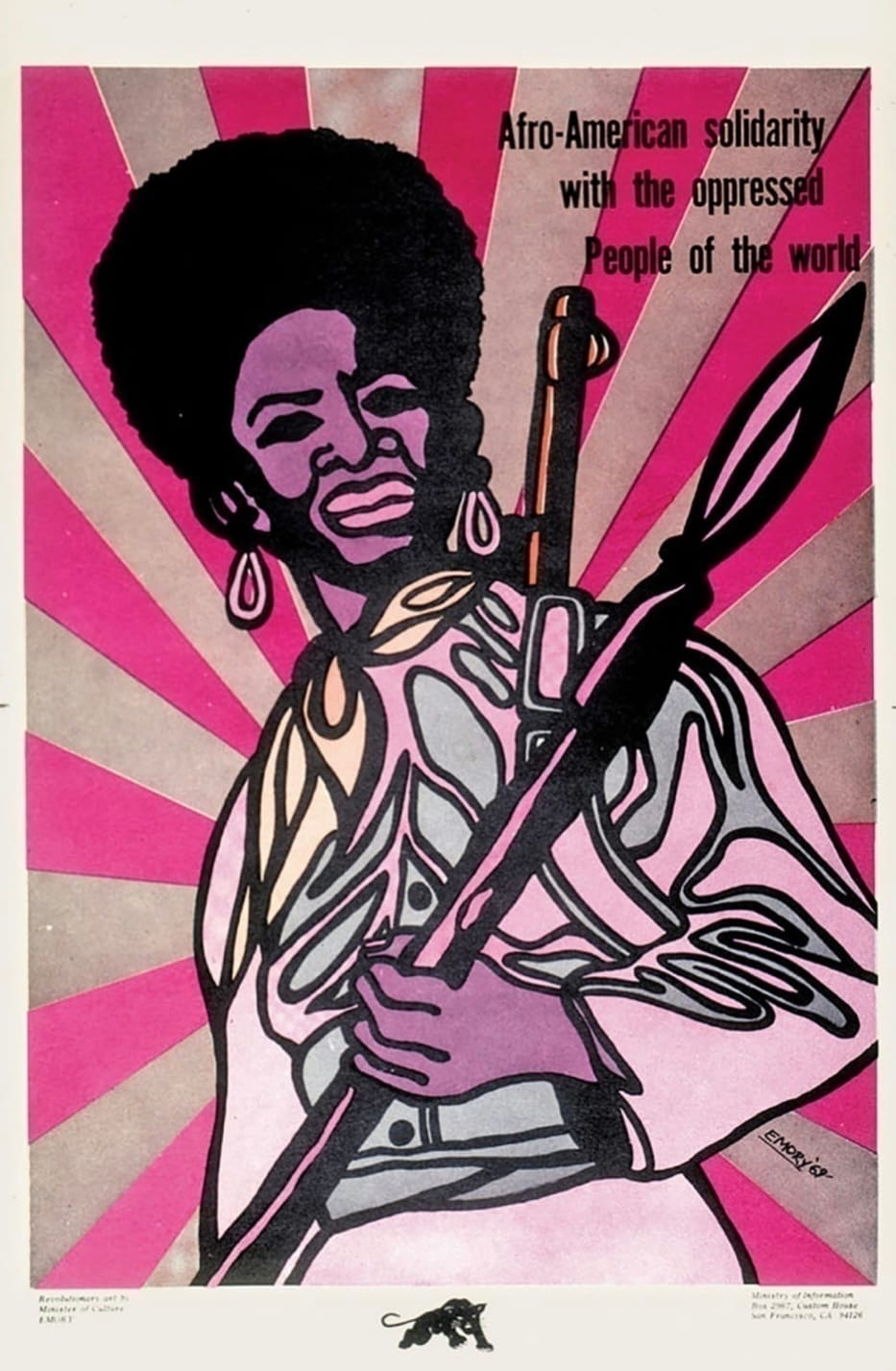
Philip Guston’s work from the early ’70’s till his death gives an honest editorial of his own mortality, his thoughts on racism and society as a whole.
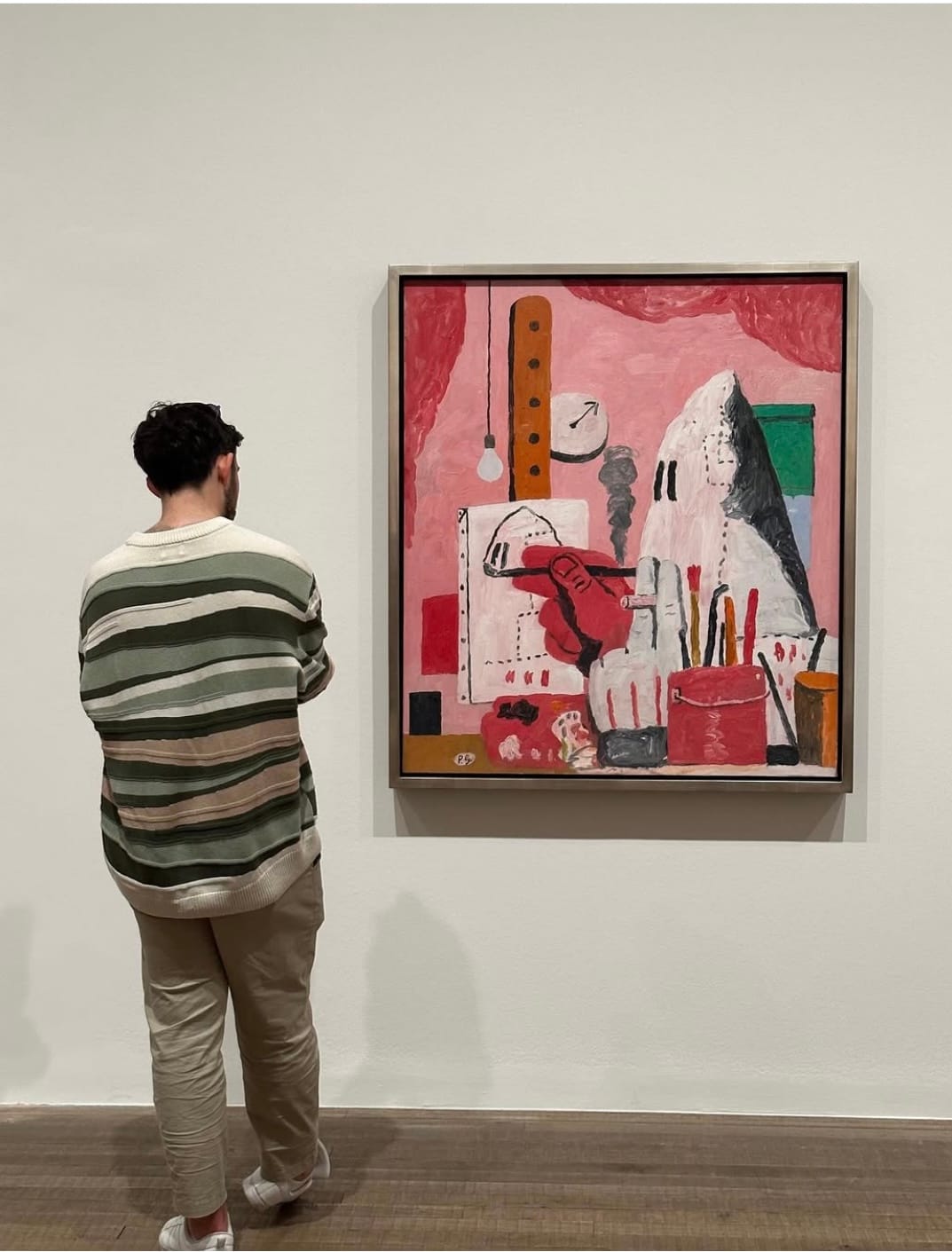
George Condo’s work I see and understand as just a visual language that speaks to me.
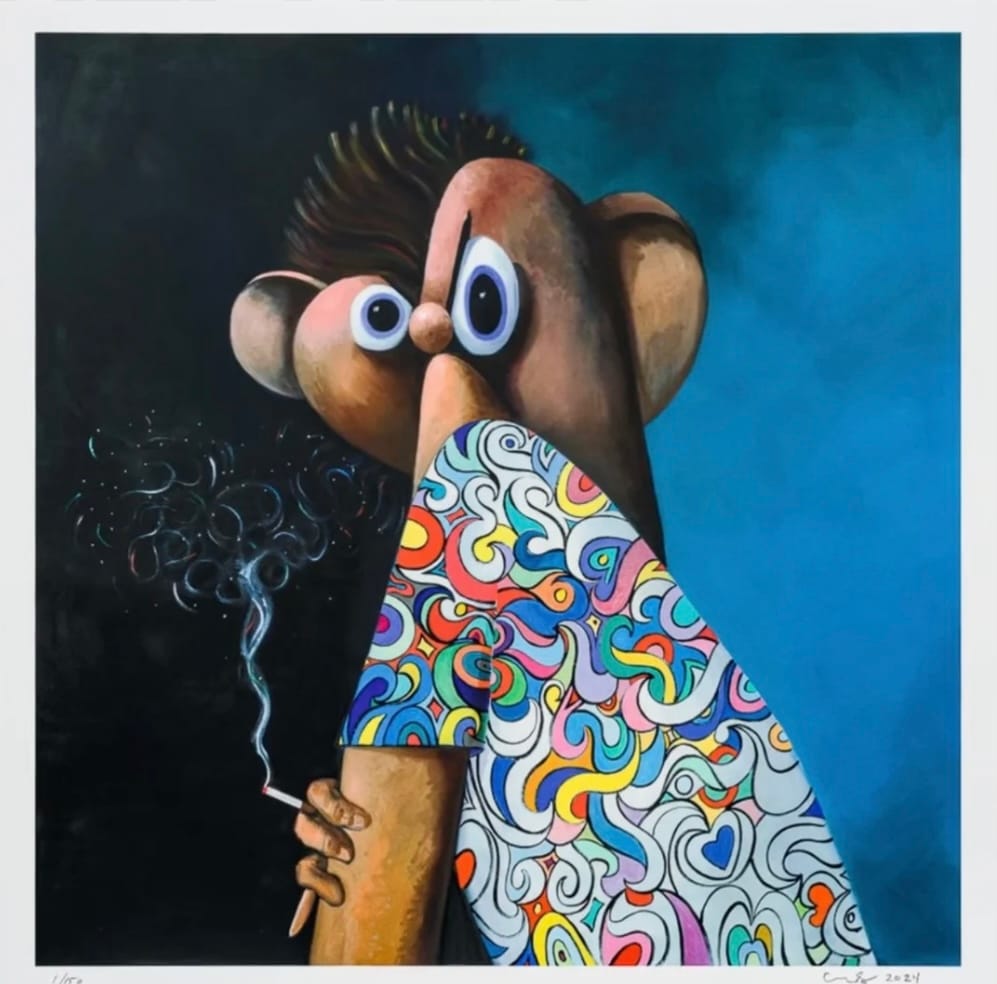
Henry O Tanner not only created works that every HBCU student has seen, but also broke barriers, white, black and International to prove that he was simply an “artiste extraordinaire!”
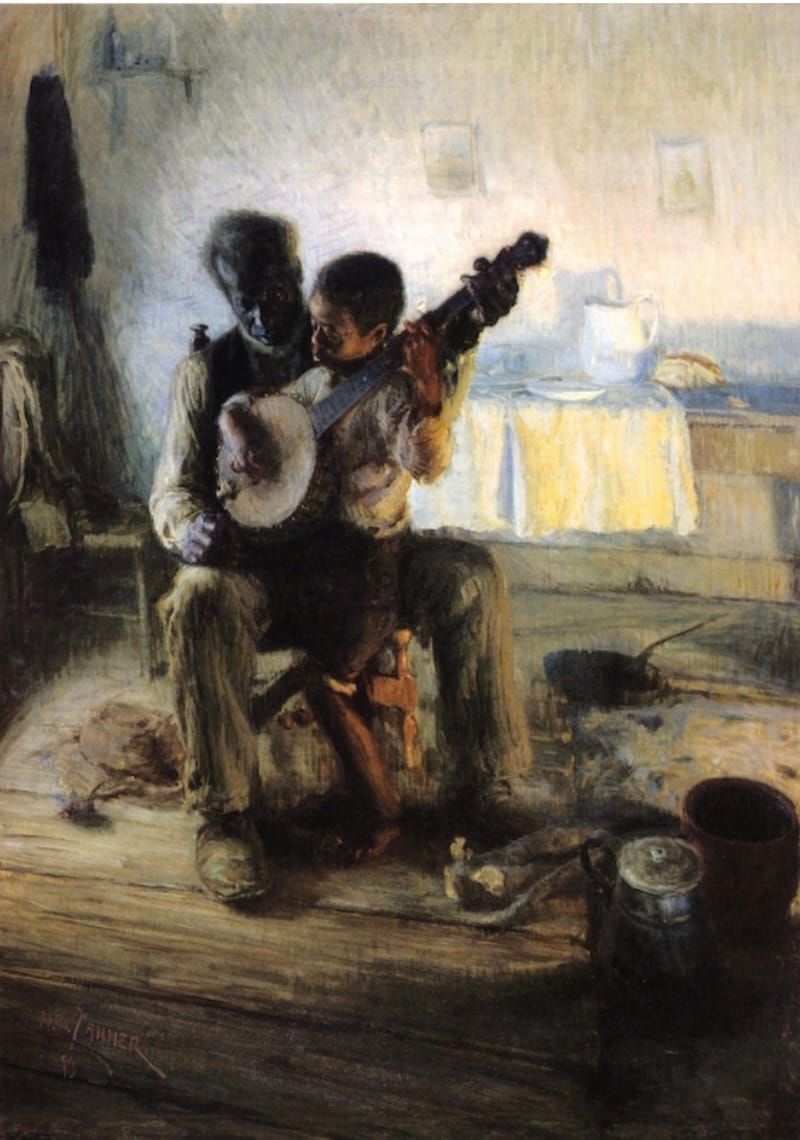
Q: You’ve also mentioned that great 20th century writers influenced your creative voice. Which ones have influenced you most and in what ways?
A: Albert Camus, Ernest Becker, Eric Hoffer, Erich Fromm, Carl Jung, Ayi Kwei Armah, Jidduh Krishnamurti, Yuval Noah Harari, Slavoj Zizek, Francis Fukuyama, David Graeber to name a few have all had an effect on me because of their differing views backed with great intellectual depth and academic study.
My work is an ongoing conversation with myself about these many influences, daily life and a search for information and conversation with my peers. There are different ways of saying things, and when you are direct it can be construed as being very divisive. How do you keep people from misusing your words? How can you use nuance in your work? When viewers come to my work, they find that the more they look at it, the more they see. So I am also in conversation with them too.
Q: What are some of the biggest challenges you faced as you established yourself and how did you overcome them? What has made DC a good place for you to live and work?
A: The greatest challenge I’ve faced in establishing myself is overcoming ME. Getting past my own fears surrounding failure, my ego, self-inflicted traumas and even the fear of possible success has led me down questionable roads and into murky troubled waters, but I’ve learned to be patient and firm with myself. Just chop the tree. Take your time, stay on task. Being in DC, I'm thirty minutes from my hometown, but the Supreme Court is literally my back porch. The museums are here. The access to so much is here. Plus there's the conversations I can have with people who are decision makers. It's cool.
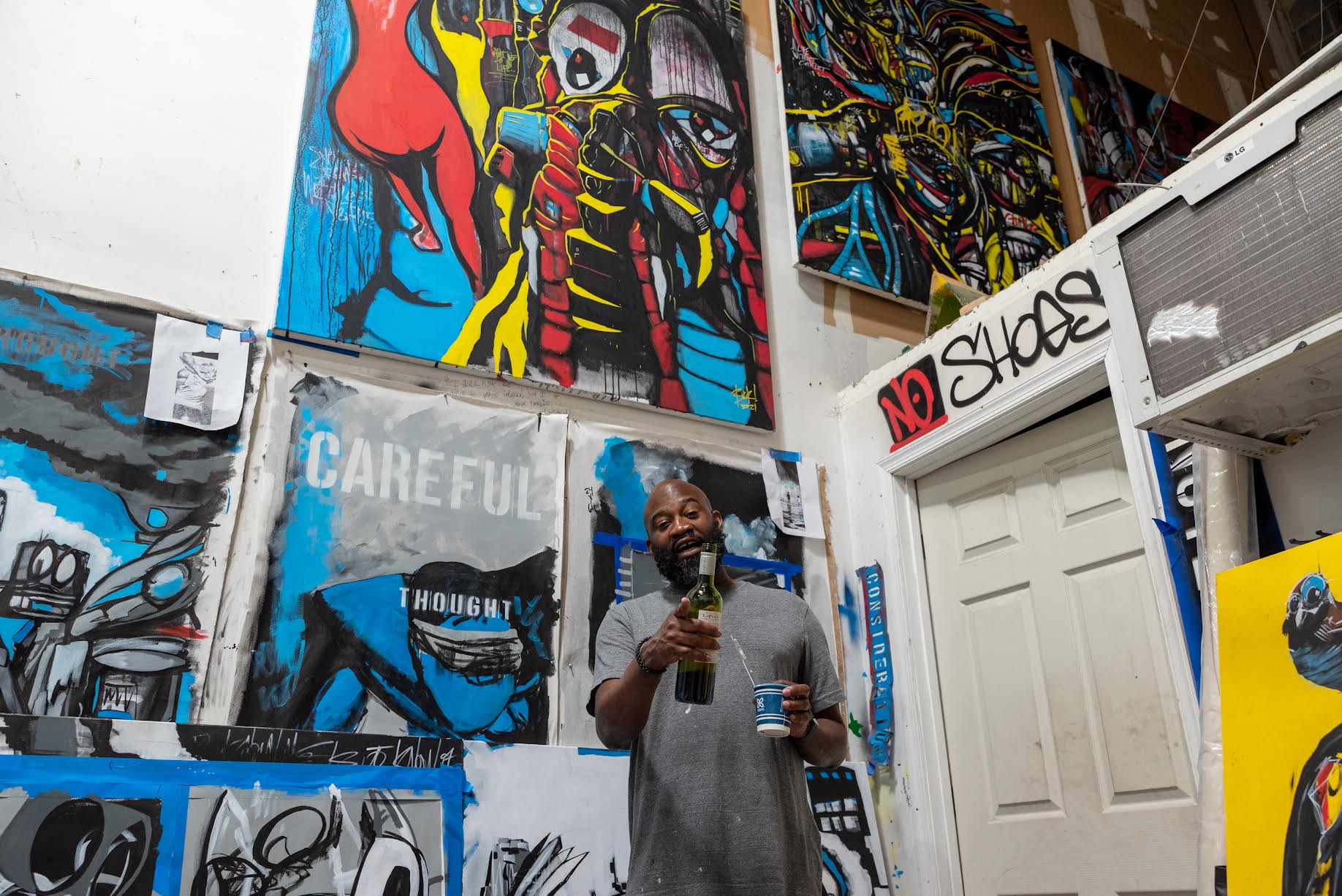
Q: Your work is really rich and layered with words and visuals. Tell us a bit about your process for creating a piece.
A: My process begins with dialogue between my peers, friends and family around our humanity. Then I begin (re)gathering books, images, video and audio to work from. Then it’s paint, written text, breathe. Talk, paint, written text, new music. Paint, paint, paint, new music, breathe. The idea is to keep creating and building the canvas until you see something…anything…that makes you say “Oooh!”. Paint, written text, breathe. Talk, paint, written text, new music. Paint, paint, paint, new music, breathe. Until I look up and say…”Damn that’s hard (amazing)!”
Q: To what degree do you find current events, especially now, creeping onto your canvases? What do you find yourself communicating to viewers in your pieces right now? And what are those viewers communicating back to you about that work?
A: The current zeitgeist profoundly affects my work. I don’t attempt to speak to merely day-to-day events, especially not daily trifles or follies between tribes or individuals, but I do try to speak to the overarching themes that speak to the cycles of human progress and fallibility.
I believe most folks that enjoy what I create are appreciative of the time it takes to consume and that it can’t all be consumed at once. It’s a meditation for the viewer as much for myself.
Q: In what ways do artists help the public navigate turbulent and uncertain moments like the one we’re in?
A: Art can be a weather vane, a call to arms, be the news itself, it can be conflict, a distraction, a salve, or even nothing. The artist chooses their own adventure and you’re along for their ride. You choose whether you’re buying a ticket or not and for how long.
Q: What’s a typical day for you?
A: I’m a night owl and a late riser, but once I get moving I’m shooting for a walk, then an espresso, followed by a drive out to the studio. I'm usually in studio with folks for the next 6 to 10 hours. Music. Incense. A toast (A little bit of Jameson lowers the inhibition)…then work….and paint. I try to escape myself by 1:00 or 2:00 a.m. Rinse repeat.
Q: What do you like to do when you’re not in the studio?
A: Good libations. Good food. Good music. Good museums.
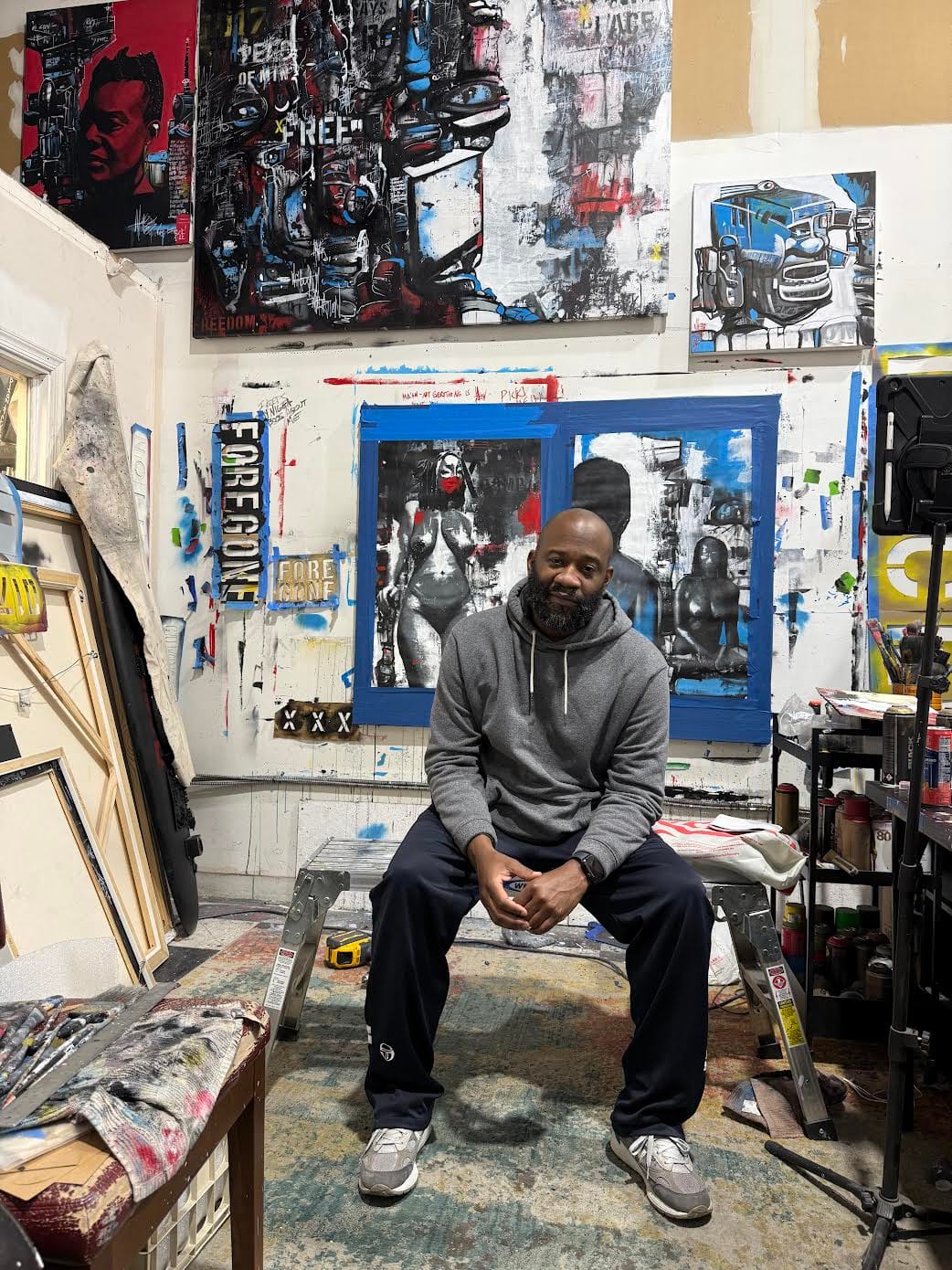
Q: Anything else on your mind today?
A: There’s so much on my mind. At the top: How do WE (humanity) overcome ourselves again and again? How do we push humanity forward? We are all here to help one another, how can I help the most people possible? Am I helping? Am I hurting? How do we get past the hate and the fear that consumes us? Is there enough empathy to get us thru this next shit show? How much is social media rotting our brains? Is year-round watermelon a good thing? Do people actually read enough history to notice we’re in a loop, but with softer edges, that we’ll repeat again and again?
Writing prompt: What's on your mind today?
First forget inspiration. Habit is more dependable. Habit will sustain you whether you're inspired or not. Habit will help you finish and polish your stories. Inspiration won't. Habit is persistence in practice.
-- Octavia Butler
Endnotes
What I'm listening to: I went to my local record store with my dog this past Wednesday. He was mostly good, but he kept pawing at the bin that had the new Lady Gaga album, and I wasn't feeling that on vinyl. But I did pick up Amy Winehouse's first album "Frank" (which I had been looking for because I love it) and Charles Mingus' "The Black Saint and the Sinner Lady" and had myself a most excellent listening party.
What I'm writing: Fellow history geek Stephanie Chandler turned her passion for the past into a riveting walking tours business in Tallahassee, Florida. I spoke with her recently about her aim to teach history in a way that's fun and engaging, and how those lessons help us all feel like we are connected to something bigger and deeper.
Where I'm talking: It has been ages since I've spoken about my first book, The General's Niece, but Charif Ahmed was kind enough to have me on his podcast recently to discuss Genevieve de Gaulle's impact during World War II and afterwards. Shoutout to my Duran Duran Funko Pops, which appeared in this broadcast, much to my delight. Given my early morning sharpness (or lack thereof), I feel like they pretty much stole the show.
What I'm reading: I just finished Surreal: The Extraordinary Life of Gala Dali by Michele Gerber Klein. Mrs. Dali certainly was in the thick of things during the Surrealist moment, but I felt like the book was more about the era (which was certainly interesting) than Dali herself, alas. Two questions: What are you reading right now that you love? And if you're a biography reader, what makes a great biography in your eyes?
What I'm looking forward to: That new Jon Hamm show on Apple TV+.
Where I hope you'll donate this week: We need art and artists in a very big way right now. Please consider a gift to American for the Arts Action Fund, which pushes for arts and arts education at the federal, state, and local level.
Next week: F2 racing phenom Max Esterson is all gas, no brakes. Could he be America's next great F1 star? I spoke to him and a bunch of other racing insiders about this – and his unconventional rise through the racing ranks – recently for a cover story in Palm Beach Illustrated. So I'll have that, and the usual fare. Thank you again for being here. If you know anyone who might like this weekly newsletter, please encourage them to join in on the free fun!
Paige Bowers Newsletter
Join the newsletter to receive the latest updates in your inbox.

